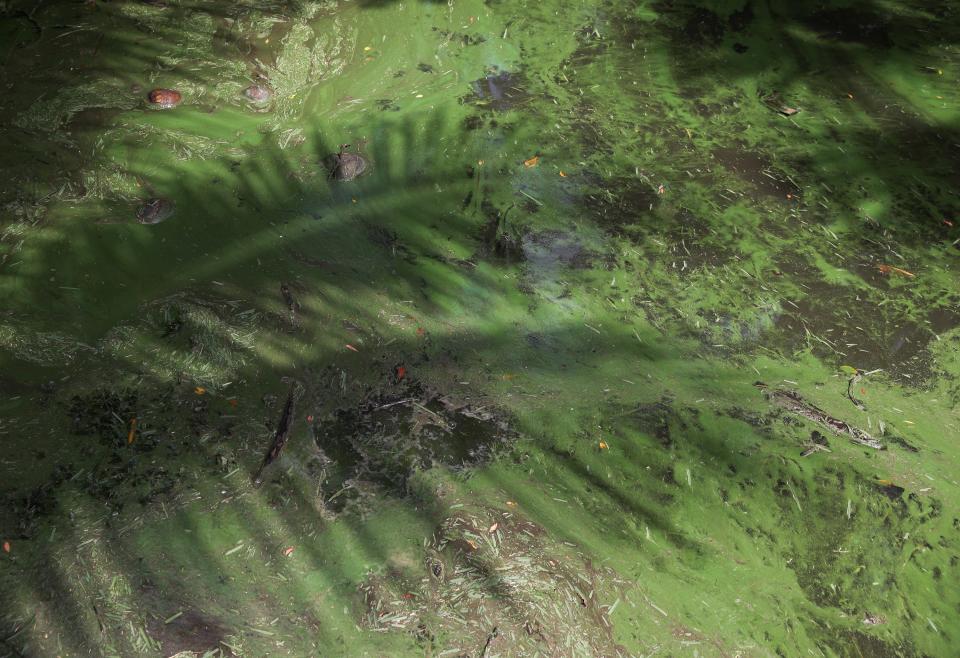Algae in Martin waters; Mast pens letter to Army Corps. Will either stop discharges?
- Oops!Something went wrong.Please try again later.
STUART — It's algae season in Martin County waters.
Bright sunny days, after an unusually cloudy winter, are fueling blooms of microcystis aeruginosa in the C-44 Canal and downstream in the South Fork of the St. Lucie River. The cyanobacteria, commonly called "blue-green algae," can be toxic and harmful to people and pets.
Against that backdrop, U.S. Rep. Brian Mast of Fort Pierce on Monday sent a letter to the Army Corps of Engineers' leadership, once again urging the agency to stop Lake Okeechobee discharges to the St. Lucie River.
"The ongoing discharges are not only incredibly damaging to our estuary, but directly contradict the [Army Corps'] best available science and modeling," Mast notes.
Where is the algae?
Algae has been popping up in different spots across the Lake Okeechobee system for a few weeks now and the Department of Environmental Protection has been testing water samples in these areas.
Most recently, DEP tested the water at the 96th Street bridge Monday and noted that algae was visible, according to the FDEP Algae Dashboard. DEP has not posted results indicating the type of algae, whether it contains the toxin microcystin, and if so, in what concentration. Results typically take 3-4 days, a DEP spokesperson told TCPalm.
Martin County residents told TCPalm they also saw algae in the St. Lucie River near Southwest Harbor Street and in the C-44 Canal near Army Corps campground boat ramp. One resident said they reported the Harbor Street algae to DEP, but a spokesperson has not confirmed that or said whether DEP tested that site.
What did Mast say to the Corps?
Anyone who has followed Mast's career since he was first elected to represent this district knows he has a bristly relationship with the Army Corps. During his tenure, he has called officials to the carpet in House chambers, addressed them at public hearings and other meetings, guided them on tours of problem areas, penned numerous letters and created laws to steer decisions with one objective in mind: stopping discharges to the St. Lucie River.
His latest letter lays out reasons to stop the discharges. He asks why the agency insists on using the Lake Okeechobee Regulation Schedule 2008 (LORS08) instead of the nearly completed Lake Okeechobee System Operating Manual (LOSOM) expected to finally be adopted sometime later this year.
“The Army Corps announcing a two-week pause in discharges and expecting us to be happy about it is like a bully taking a day off from beating the crap out of you and expecting you to say thank you,” Mast said to TCPalm.
The two-week pause is a routine procedure that was planned before Mast sent his letter to the Army Corps.
Read Mast's letter below:
Mast has plenty of detractors who say he hasn't done enough to stop discharges. To those critics, I point out that NO ONE in his position in the last 100 years of this government-sanctioned pollution has done ANYTHING to stop discharges. Neither has any president, regardless of party affiliation, nor senator or governor, by the way. Only Mast has even communicated to the Army Corps and received a response.
The process may be slow and tedious, but in the last eight years, at least it has been moving in the right direction thanks to Mast.

Will this be the end of discharges in 2024?
So far, 56.2 billion gallons of Lake O water has dumped into the St. Lucie River since Feb. 17. In that time, the lake has come down a mere 9 inches.
What will the agency do after the two-week pause that begins Saturday? Maj. Corey Bell told TCPalm Friday that the Corps will "work with stakeholders with the next release pattern after the 2-week pause."
"We received notice from FDEP that they sampled several locations of visible blooms along the canal. Results from these sampling efforts take a few days to come back so it is possible the gates will be closed for the two-week pause by the time we know the toxin concentrations. We will continue to monitor our locks/spillways at [Port MayacaLock and Dam] and [St. Lucie Lock and Dam] and modify operations if we need to, based on visual observations. We will await the sampling results and make a decision when they are released," Corps spokesman J.P. Rebello said to TCPalm.
An active hurricane season could force the Army Corps to have no choice but to discharge water.
As weird as it sounds, the faster and thicker the algae blooms grow, especially in key spots like the Port Mayaca Lock and Dam, the sooner the discharges may end. The Army Corps knows that pouring toxic algae into our communities— something they did in 2005, 2013, 2016 and 2018 — is not good optics.
Why discharges? El Niño rains to blame for Lake Okeechobee water sent to the St. Lucie River, Stuart
LORS not LOSOM: Army Corps: Why the new Lake Okeechobee management rules wouldn't have stopped discharges
Mast's pressure may also help. The Army Corps has a hard time justifying some of its decisions to Mast, who represents his constituents on clean water.
The discharges need to stop. If lake level is a problem, then quit letting it into the north end. The other thing that desperately needs to happen is for the Army Corps to create and expand infrastructure that carries the same volume south as can flow east and west.
That's a big ask, but it has to happen if the estuaries are ever going to be off the hook.
Ed Killer is an opinion columnist for TCPalm. This is his opinion. Email him at ed.killer@tcpalm.com.
This article originally appeared on Treasure Coast Newspapers: Mast urges Army Corps: Stop Lake O releases amid St. Lucie River algae

